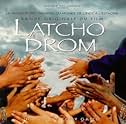This film is a tapestry, a series of portraits of Rom communities woven together by music. It's very much a musician's film, because of the paucity of spoken dialogue - and what dialogue there is, is not important to the structure of the narrative. Some might expect a National Geographic tale of "customs, dress, and music" or a plot-line orbiting a few central characters - don't look for that here.
This is because it paints a portrait of a family of peoples, rather than telling a story of individuals. The plot is the story through space (India to Andalucia) and/or/ time (we cannot tell) of a people. There is no need of narration. You get a sense of a joyous people, strongly linked in small communities where social interaction is very important. And a great sense of sadness in parts, at their rejection by society at large.
So it's a paean to Rom culture, very beautifully shot, with a wide spectrum of Rom music, and a sting in the tail which is the oppression these people have faced, and still face.
















